|
|
![]()
FOREST HEALTH - HARDWOOD LEAF DISEASES
Leaves hold a great amount of nutrients, sugars, and other food resources that attract a wide range of pathogens. Despite the structural and physiological defenses of a leaf, pathogens frequently invade leaf tissues. Symptoms generally include browning, discoloration, curling, and leaf drop. Of course, these are symptoms similar to many insect infestations and nutrient stresses as well. Close examination of an affected leaf (several leaves are better) will usually show a lack of insect presence. Eliminating insects, then a pathogen may be the next likely cause. Wilting and browning leaves often result from a disease of the tree's vascular system, unseen under the bark. Several of the common vascular diseases are mentioned here, but properly belong in the stem and branch disease section. Red text indicates an exotic pest.
| Anthracnoses Beech Leaf Disease (not beech bark disease) Dutch Elm Disease Maple Tar Spot Oak Wilt Septoria Canker Wilts / Verticillium Wilt |
| Anthacnoses (Gloeosporium & Gnomonia spp.): brown spots appear on leaves and can expand to cover the entire leaf, most common in the spring/early summer when weather conditions are cool and moist, more common near watering systems (lawns, golf courses, etc.) |
| Hosts: many hardwood species, in the UP-mostly oaks, maples, and balsam poplar |
Beech Leaf Disease (unknown cause 2018): early defoliation, dark-striped band between the leaf veins, smaller leaves, canopy thinning. Not yet known to be in Michigan but it's nearby in northeastern Ohio. If sightings are suspected, please report to the DNR at DNR-FRD-Forest-Health@michigan.gov or call the Lansing office at 517-284-5895. Clear photos are needed to help diagnose. This is different than beech bark disease (a combination of a scale insect and Nectria fungi). U.S. Forest Service bulletin. |
| Hosts: all Michigan beech species |
Dutch Elm Disease (Ceratocystis ulmi): biologically, Dutch elm is a vascular disease that results in browning and leaf loss that might occur throughout a growing season and sometimes multiple growing seasons, it often begins with the yellowing of the leaves on a single branch (called flagging), introduce in 1930 |
| Hosts: commonly American and slippery (red) elm although all native elms are vulnerable |
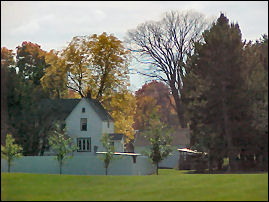 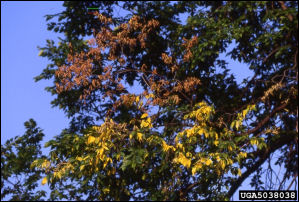 |
Maple Tar Spot (Rhytisma acerinum): not a serious disease but can be locally common, especially during cool-moist summers, circular spots appear dark brown/black |
| Hosts: all maples |
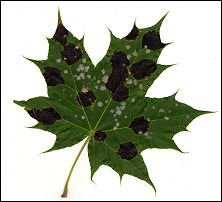 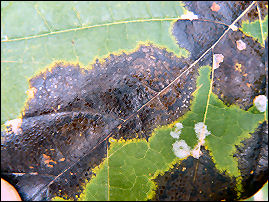 |
Oak Wilt (Bretiziella fagacearum, formerly Ceratocystic fagacearum): biologically, oak wilt is another vascular disease that results in browning and leaf loss within a period of several weeks (which is considered quick), introduction unknown but it's been around since at least the 1940s |
| Hosts: all oaks but oaks in the red oak group are most susceptible and succumb the quickest |
|
Septoria Canker (Septoria musiva): brown spots with light-colored centers appear on leaves, leaves can turn brown, outbreaks can occur regionally, favored by wet summers, fungus can move to twigs and allow more harmful pathogen introductions |
| Hosts: aspens, balsam poplar, certain breeds of hybrid poplar |
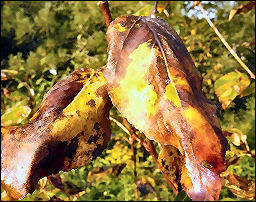 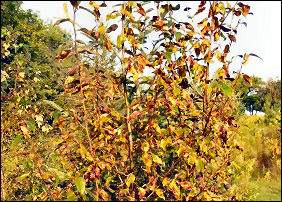 |
Wilts: a number of pathogenic wilts affect various tree species; diagnosis can be difficult in some cases e.g. maple dieback and ash yellows; browning and wilting leaves can be symptomatic of many health issues including diseases, insects, and tree stress; for example, emerald ash borer causes leaf loss due to lack of water flow from disrupted vascular tissue |
| Hosts: all tree species |
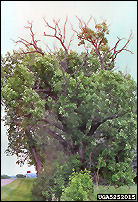 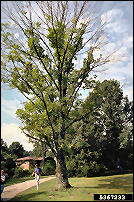 [maple dieback, ash yellows] |
|
|
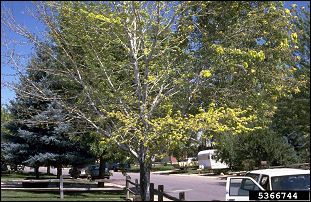 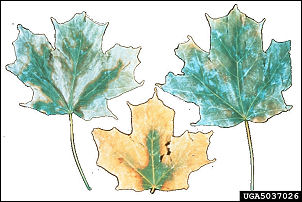 |
Image Citations
Antracnose-maple leaves - Simeon Wright, Michigan DNR
Beech Leaf Disease (2) - https://bygl.osu.edu/node/885
Dutch Elm Disease (2) - Joseph O'Brien, USDA Forest Service, Bugwood.org
Wilt (1), Maple Dieback - Joseph O'Brien, USDA Forest Service, Bugwood.org
Wilt (2), Ash Yellows -
William Jacobi, Colorado State University, Bugwood.org
Verticillium Wilt (1) - William Jacobi, Colorado State University, Bugwood.org
Verticillium Wilt (2) - Joseph O'Brien, USDA Forest Service, Bugwood.org
All others - Bill Cook, Michigan State University Extension
Click HERE
to return to the U.P. Tree ID home page.
Click HERE to return to the Forest Health home page.
This site created and maintained by Bill Cook, MSU Extension Forester for the Upper Peninsula of Michigan. Editing and modification is ongoing. Submit suggestions, questions, and corrections to cookwi@msu.edu or call 906-786-1575.